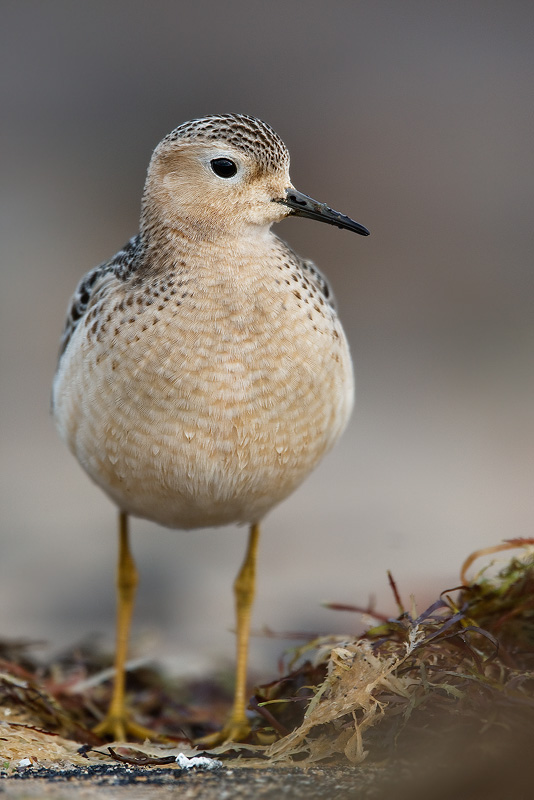Buff-breasted sandpiper on:
[Wikipedia]
[Google]
[Amazon]
The buff-breasted sandpiper (''Calidris subruficollis'') is a small shorebird. The species name ''subruficollis'' is from Latin ''subrufus'', "reddish" (from ''sub'', "somewhat", and ''rufus'', "rufous") and ''collis'', "-necked/-throated" (from ''collum'', "neck"). It is a calidrid sandpiper.
 ''C. subruficollis'' breeds in the open arctic tundra of
''C. subruficollis'' breeds in the open arctic tundra of
Buff-breasted sandpiper Species Account
– Cornell Lab of Ornithology
- USGS Patuxent Bird Identification InfoCenter * * * {{Taxonbar, from1=Q27452709, from2=Q47109 buff-breasted sandpiper buff-breasted sandpiper Birds of the Arctic Native birds of Alaska Birds of Canada Birds of South America buff-breasted sandpiper buff-breasted sandpiper
Description
This species is brown above, and has a buff face and underparts in all plumages. It has a short bill and yellow legs. Males are larger than females. Juveniles resemble the adults, but may be paler on the rear underparts.Distribution and habitat
 ''C. subruficollis'' breeds in the open arctic tundra of
''C. subruficollis'' breeds in the open arctic tundra of North America
North America is a continent in the Northern Hemisphere and almost entirely within the Western Hemisphere. It is bordered to the north by the Arctic Ocean, to the east by the Atlantic Ocean, to the southeast by South America and the Car ...
and is a very long-distance migrant, spending the non-breeding season mainly in South America, especially Argentina.
It migrates mainly through central North America, and is uncommon on the coasts. It occurs as a regular wanderer to western Europe, and is not classed as rare in Great Britain or Ireland, where small flocks have occurred. Only the pectoral sandpiper is a more common American shorebird visitor to Europe.
This species nests as far north as Canada including Alaska on the ground, laying four eggs. The male has a display which includes raising the wings to display the white undersides, which is also given on migration, sometimes when no other buff-breasted sandpipers are present. Outside the breeding season, this bird is normally found on short-grass habitats such as airfields or golf-courses, rather than near water.
These birds pick up food by sight, mainly eating insects and other invertebrates. The buff-breasted sandpipers are known to prey on '' Bombus polaris'', a species of bumblebee found within the Arctic Circle
The Arctic Circle is one of the two polar circles, and the most northerly of the five major circles of latitude as shown on maps of Earth. Its southern equivalent is the Antarctic Circle.
The Arctic Circle marks the southernmost latitude at w ...
. They will either eat the bees or feed them to their young. They are often very tame.
Buff-breasted sandpipers are suspected to have hybridized with the white-rumped or Baird's sandpiper.
In South Asia and Australia
This species has been sighted in South Asia on at least three occasions. It is believed that instead of going to Argentina, this bird might have been wind-blown from the Great Plains Flyway of North America and landed up in South Asia. In November 2011, this species was sighted by Dr.Jayan Thomas and P.C. Rajeevan near Kannur, Kerala in South India. and photographed by Dr. Jayan Thomas. The buff-breasted sandpiper has also been recorded inAustralia
Australia, officially the Commonwealth of Australia, is a Sovereign state, sovereign country comprising the mainland of the Australia (continent), Australian continent, the island of Tasmania, and numerous List of islands of Australia, sma ...
on at least eight occasions.
In 1978, Phillips recorded the species from Sri Lanka
Sri Lanka (, ; si, ශ්රී ලංකා, Śrī Laṅkā, translit-std=ISO (); ta, இலங்கை, Ilaṅkai, translit-std=ISO ()), formerly known as Ceylon and officially the Democratic Socialist Republic of Sri Lanka, is an ...
, and after that very few sightings were recorded. In 2001 a single bird was also recorded in Marievale, South Africa.
References
External links
* * *Buff-breasted sandpiper Species Account
– Cornell Lab of Ornithology
- USGS Patuxent Bird Identification InfoCenter * * * {{Taxonbar, from1=Q27452709, from2=Q47109 buff-breasted sandpiper buff-breasted sandpiper Birds of the Arctic Native birds of Alaska Birds of Canada Birds of South America buff-breasted sandpiper buff-breasted sandpiper